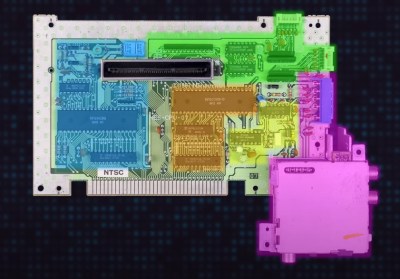No matter your age or background, there’s an excellent chance you’ll recognize the Nintendo Entertainment System (NES) at first glance. The iconic 8-bit system not only revitalized the gaming industry, but helped to establish the “blueprint” of console gaming for decades to come. It’s a machine so legendary and transformative that even today, it enjoys a considerable following. Some appreciate the more austere approach to gaming from a bygone era, while others are fascinated with the functional aspects of console.
The NesHacker YouTube channel is an excellent example of that latter group. Host [Ryan] explores the ins and outs of the NES as a platform, with a leaning towards the software techniques used to push the system’s 6502 processor to the limits. Even if you aren’t terribly interested in gaming, the videos on assembly programming and optimization are well worth a watch for anyone writing code for vintage hardware.

In truth we’re a bit late to this party, as the channel has been up and running for about a year now. But a recent installment, titled “NES Hardware Explained” is what really got us interested. In this video, [Ryan] first takes the console apart in classic teardown style, showing how all the bits and pieces come together. That includes the occasional pause to show the pinout of a particular connector or some other interesting hardware detail.
After that, he breaks the main PCB down section-by-section, explaining the function of each IC on the board. This is a particularly nice resource for anyone who might need to do some repair work on their system, or perhaps those looking to piece together their own breadboard NES clone. We appreciate that he also takes the time to explain how to put the system back together, paying close attention to getting its notoriously finicky cartridge connector working again.
We really like the style of the NesHacker videos, which are well produced without feeling forced. There’s no annoying music or shocked-face thumbnails, just a competent discussion of a fascinating device. While this latest entry might be a bit pedestrian for some in the audience, we’re willing to bet the previous deep-dives [Ryan] has uploaded to the channel will teach you something new about this legendary machine.
















At least, it had proper shielding. And an good old 7805.. 🙂👍
By “proper shielding” you mean it lacked proper EMF filtering 😂
Awesome thank you!
“The iconic 8-bit system not only revitalized the gaming industry”
Only in the US of A and only for consoles. Computer gaming never needed ‘revitalizing’.
“but helped to establish the “blueprint” of console gaming for decades to come”
You mean locked down and locked in.
The “plug the cart in and press down before closing the cover” concept was to separate the NES from other gaming consoles at the time. There’s a product called “blinking light win” (sold out) that replaces this mechanism with a more reliable direct insert tray and socket (like the top loading NES) so you shove the cart in parallel with the mobo and it works every time.
huh now that you mention it, when i was a kid our NES was way newer than our atari 2600 but only the NES had trouble reading carts (and the atari was not unused by any stretch)
The NES was made to look and feel like a VCR, afaik.
It takes game cassettes like video tapes.
Btw, ZIF sockets are the higher-end, professional types.
They’re also used by EPROM programmers.
That “direct insert tray” mechanism causes much more friction to the contact of game cassettes. Technically, it’s inferior.
Personally, I prefer to keep/fix the old mechanism and keep my carts in a clean condition. Should fix the issue, too.
If you look at the side profile of the connector you can see that it is a clever mechanism, but not as reliable as direct insert (such as a PCI expansion card on a pc). While it is ZIF, I think it’s a unique and flawed design, not the same design as a ZIF socket. Also, the Game Genie used a thicker PCB so it could make contact without pushing down (it stuck out the front of the NES) and would be really tight in a top loader NES. I like to use a q-tip and put deoxit on all my cart pins.
Yeah I remember back in the day using the game genie as a sort of hack to get games to boot correctly, and it was likely from a worn out connector in hind sight.